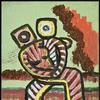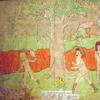US Art Market Reports Highest Ever Level of Sales While Overall Global Market Values Fall
- HELVOIRT, Netherlands
- /
- March 09, 2016

The 2016 TEFAF Art Market Report shows that global sales fell 7% during 2015 from $68.2bn to $63.8bn and the volume of sales declined by 2% to 38.1 million. The picture that emerges in 2015 is of a highly polarized market, whereby most of the value within the market is shared between two sectors – Post War and Contemporary and Modern art - and is concentrated in sales at the very highest price levels.
Although the global sales figure fell in 2015, sales in the US rose by 4% to their highest ever total of $27.3bn confirming its position as the global market leader, with a 43% share of total sales values. The UK, in second place, had a 21% share and China accounted for 19% by value.
From 2012 – 2014, China remained significantly smaller than the US but ahead of the UK, which was third in global rankings. In 2015, against the backdrop of economic contraction and uncertainty alongside poor sales in many sections of the auction market, the Chinese market experienced a significant decline, with total sales dropping 23% to $11.8bn. The UK regained its position as the second largest market worldwide in 2015, despite sales falling 9% in value to $13.5bn; sales overall in Europe were patchy and generally stagnant.
The market remained dominated by value at the high end. Works sold for over $1m accounted for the majority of value in fine art auction sales (57%) during 2015, despite representing less than 1% of all transactions. Sales at this level continued to be generated by a tiny fraction (1%) of all artists selling work at auction, as the focus of many high-end collectors continued to be centred on a narrow group of artists.
Growth in the million dollar plus segment far outpaced growth in all other segments. In the decade to 2015, this segment grew in value by 400%, four times or more than the rate of growth in sales in the low and medium segments. Within this high end, the ultra-high end (works priced over $10m) also outperformed, with over 1,000% growth in the same period. This ultra-high segment accounted for 28% of total sales by value in 2015 despite representing a very small fraction (0.1%) of overall transactions in the fine art auction market, and was the only segment of the market to increase in value over 2015 (advancing 19% year-on-year).
Private sales by dealers and other agents accounted for 53% of the total market by value, with sales at auction accounting for 47%. Furthermore, dealers estimated that 40% of their sales on average were made at art fairs in 2015. Despite declining global sales overall, the online sector continued to be a focus of attention and a relative bright spot in the market, with sales increasing 7% year-on-year. In 2015, sales of art online, which included online sales by traditional off-line dealers and auction houses, were estimated to have reached $4.7 billion or 7% of the global market by value.
Looking at different sectors within the art market, the largest single sector continued to be Post War and Contemporary Art, which accounted for 46% of the market by value and 41% of transactions. Following two years of significant growth, however, sales at auction fell by 14% to $6.8 billion with a 20% drop in the number of transactions.
Sales of Modern art did relatively better and were where the highest record prices at auction were found in 2015, including the world record prices for works by Picasso and Modigliani that both exceeded $170 million each. The sector fell by 1% to $4.5bn although the number of transactions declined by 20%. This sector accounted for 30% of the fine art auction market by value and 27% by volume.
Sales at auction of European Old Masters showed a moderate increase of 4% by volume, although sales values fell by 33%. European Old Masters accounted for 6% of lots sold and 4% of fine art sales at auction. In contrast, private sales of European Old Masters, which made up a very important component of aggregate values, were particularly strong.
In addition, some of the decorative art sectors showed a positive trajectory over 2015. One of the largest decorative art sectors, Chinese decorative art and antiques, increased 6% year-on-year to $2.2bn, with porcelain and ceramics garnering some of the highest prices.
The global art trade spent an estimated $17.8 billion on a range of external support services directly linked to their businesses, with spending increasing 3% year-on-year despite the decline in sales in the art market.
In 2015 there were just over 310,400 businesses operating in the global art and antiques market. The global markets supported jobs for over 3.2 million people in auction houses, galleries, dealers and a range of external support services that are directly linked to the art market.
The 2016 TEFAF Art Market Report will be presented by Dr. Clare McAndrew on the 11th March at 11am during The Art Market Symposium, this year entitled Informing The Art World - Speed, Needs & Globalisation, as part of TEFAF at the MECC, Maastricht. Following the presentation of the report will be a panel discussion chaired by Thomas Marks, editor of Apollo, with Georgina Adam, Art Market editor-at-large at The Art Newspaper and columnist at the Financial Times, Jacob Pabst, CEO of ArtNet and Dr. Clare McAndrew.






100x100_c.jpg)








![Peter Paul Rubens (Flemish, 1577–1640), After Titian (Tiziano Vecelli) (Italian [Venetian], c. 1488–1576), Rape of Europa, 1628–29. Oil on canvas, 71 7/8 x 79 3/8 in. Peter Paul Rubens (Flemish, 1577–1640), After Titian (Tiziano Vecelli) (Italian [Venetian], c. 1488–1576), Rape of Europa, 1628–29. Oil on canvas, 71 7/8 x 79 3/8 in.](/images/c/e2/2e/Jan20_Rape_of_Europa100x100_c.jpg)
